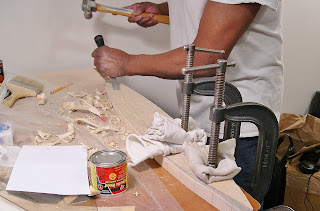Port stern view showing the intricate details of FRANCIS SKIDDY as
she appeared on the Hudson River when first built in 1852.
Since my last model build of FRANCIS SKIDDY some 30 years ago, I never imagined re-evaluating my work until a collector in the Newburgh area of the Mid-Hudson Valley communicated with me concerning the establishment of a collective body of work involving steamboats from 1830 to 1971. The steamboat of that latter period I make mention of was the last American side wheeler, ALEXANDER HAMILTON which ran on the Hudson River that summer (1971) from New York City to Bear Mountain -closing out its final excursion that year.
Although I would like to continue with the details of these other models, the focal point is FRANCIS SKIDDY. An earlier blog was written on her eight years ago which, at that time, was considered to be one of the most accurate models of the vessel to present day...However, after pouring over more data I came to discover that more details were evident for a finer, more exclusive model.
Here, in these images, I give some methods of my approach to the medium. Steamboats, particularly those that commuted in the Northeast Corridor of America, has been my niche for over 40 years. Now, I begin this blog in a two-part presentation to show my viewers how I work to achieve this level of build.
This image shows the early plan I created (c.1985) when coming into my own as a
artist/craftsman in the maritime... In this photo I am revising details which were dis-
covered while pouring over vintage photos depicting river steamboats docked
at various ports along the Hudson. After carefully study, I was able to change many
details and reconfigure many features to support my findings.
This 1859 painting by James Bard (a noted artist of Hudson River steamboats), was the basis for my earlier model(s). However, the unintentional flaw I made was dating the earlier models as being the first appearance in that year -confusing her conversion into a nightboat which occurred in 1855.
With the correct scale measurements I now proceed to transfer the data of my
templates unto the wood. For all my models the choice of pine has been the
signature. It has been (for many years) an easy wood to work with and I've been
able to hone in to its properties -achieving attractive contours both at the bow
and stern.
Carefully chiseling the contours to prevent accidental splitting.
Sanding hull to fine finish before applying decking and furniture.
Carefully carved paddlewheels are temporarily fitted to invite the overlay of
the upper deck for proper location of the paddleboxes. Measurements are very
tedious and time consuming. An eighth of an inch either way in positioning can
ruin an entire project.
Port profile view of main deck layout -which is the foundation (or cornerstone) for quality steamboat models. Everything must align perfectly...and the deck sheer should show no buckling or warping...just a nice sweep from bow to stern.
Port bow overview show penciled outlines for housing layout between the paddleboxes and smokestacks. Also shown are the railing, spar and kingpost arrangements.
Custom painting a miniature mural of the Hudson Highlands which was carried on the
paddleboxes of the dayboat FRANCIS SKIDDY during her inaugural run in 1852.
Paddlebox mural is shown before work resumes on saloon deck features.
Starboard view showing main deck after cabins in progress...
Hand carving the stanchion posts for both the deck and rail systems.This type work makes the build worthwhile -and lends to enjoyable viewing for the endless stream of clientele.
Detailed view of finished stanchions after carving...
Interior closeup showing main deck after cabin carpeted floors.
Port stern profile overview of the FRANCIS SKIDDY tie rod-king post system. Much of it had to be revised with this current build -based on relocating deck furniture on both the saloon and hurricane deck.
The HudsonRiver is a beautiful waterway that once carried steamboats of the same elegance.FRANCIS SKIDDY was one of them - now sitting in a prolific Newburgh Collection among the legends of other New York steamboat miniatures. I am honored to be a part of this historical event and can only hope that the Collection, as I know it, will remain intact for future generations.
Commissioned work can be honored for any and all Hudson River steamboats. These are fine, one of a kind models that accurately define the vessel as it appeared at any given time of its career. For more information about my line of work contact me at: Caseships@yahoo.com or call 1-774-757-7137. For my credentials and work please visit https://www.linkedin.com/in/rexstewart and https://youtube.com/c/RexStewartoriginals.
Thank you for viewing!


















No comments:
Post a Comment